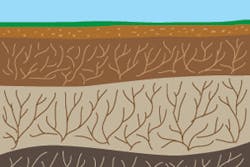Cost-Effective Erosion Control With Blankets and Mats – Part 4
TxDOT: A Diversified and Flexible Approach
The Texas DOT (TxDOT) uses erosion control blankets extensively on newly graded and seeded slopes steeper than 3:1, employing a wider range of blanket types and manufacturers than some other states. John Mason, a TxDOT vegetation management specialist in Austin, TX, explains that TxDOT leaves it up to the contractor to decide which particular erosion control blanket to use on a given project. The contractor is required to choose from TxDOT’s approved-products list. In a joint program with the Texas Transportation Institute (TTI) over the past 11 years, TxDOT has been evaluating the numerous erosion control blankets and mats available on the market. Those that pass experimental evaluation tests at TTI are put on the approved-products list. TxDOT evaluates all sorts of erosion control blankets for slopes and permanent turf-reinforcing mats for channels and ditches. Many other states also make use of the test results, which are available on-line at www.dot.state.tx.us.
Two years is the longest time that a blanket has to last for slope protection in most areas of Texas, Mason believes. After that time, there should be a good stand of grass almost anywhere in the state. In many cases of spring and summer planting, vegetation is established in as little as 90 days after seeding, and a good vegetative stand is almost always established in a single season. Eastern Texas receives much more rainfall than western Texas, points out TxDOT vegetation specialist Ben Bowers, so vegetation takes hold faster there than in the arid west.
Much depends on when a slope is graded. If a slope is graded in December, Mason says, TxDOT seeds with a temporary winter cover, such as oats or wheat, then covers the exposed slope with an erosion control blanket. In April the slope is seeded right through the erosion control blanket; the seeds fall through the blanket to the underlying soil and quickly germinate. By August there is a thick stand of grass. The blanket then needs to last from December through August–about nine months. If the slope is graded, seeded, and covered with an erosion control blanket in April, the blanket needs to last, in many areas of Texas, until August–a total of only five months.
What about stories about blanket netting getting caught in DOT lawnmowers? It is a problem, Mason says, but not a serious one. Most erosion control blankets come with plastic netting on the top and bottom, which keeps blanket fibers (straw, coir, excelsior, and so on) from washing or blowing away. If the blanket is not properly stapled down, nets can loosen and get tangled in the lawnmower blade. No safety problem here, just a matter of inconvenience. The operator has to stop the lawnmower and cut away the entangled net. With many blankets, the netting will biodegrade within a few years.
Incidentally, Mason observes, even though some blankets are designed to last for several years they might not actually last that long if the slope they are installed on is subjected to frequent mowings. After several passes a lawnmower will begin to takes its toll on even the sturdiest blankets.
Mason ticks off the types of roll-on erosion control blankets that are finding considerable use by TxDOT on slopes steeper than 3:1:
- Straw blanket, with plastic netting on the bottom and top–often the contractor’s choice when the project requires a blanket to last only a year or less. Such a short-term stint would often be the case if the blanket were being rolled down on a slope in spring.
- Excelsior blanket, with plastic netting on the bottom and top–a popular choice in Texas because of its longevity (two years and up) and cost competitiveness ($2–$3/sq yd., depending on the size of the job).
- Coir blanket with plastic netting on the bottom and top–also a popular choice in Texas, especially on projects where it might take eight to 24 months to get a dense stand of grass, so blanket durability is important.
- Jute blankets–finding considerable use in Texas. Lasting upward of two years, jute blankets are price competitive with other durable blankets, such as excelsior. Contractors need to be careful to staple down jute blanket at frequent intervals, as the blanket has a tendency to “tent” (i.e., plants growing beneath the blanket can push it up rather than grow through it).
According to TxDOT’s Bowers, the installed cost of the above temporary erosion control blankets in Texas ranges from $1.64 to $3.69/sq yd.
Mason has not seen any mixed straw-coir blankets used in Texas. Nor has he seen any hay blankets with netting top and bottom. TxDOT, though, does use blown-on hay very extensively as mulch on newly graded and seeded areas that are flat or have only mild slopes.
To select the most appropriate erosion control blanket, advises Ed Dugan, sales manager for erosion control blanket manufacturer Green & Bio Tech in Ridgefield, NJ, a consulting engineer or contractor needs to consider several factors. These include the steepness of the slope, the magnitude of the sheet flow over the slope, and the region of the country (some grasses grow better in some regions of the country than in others).


